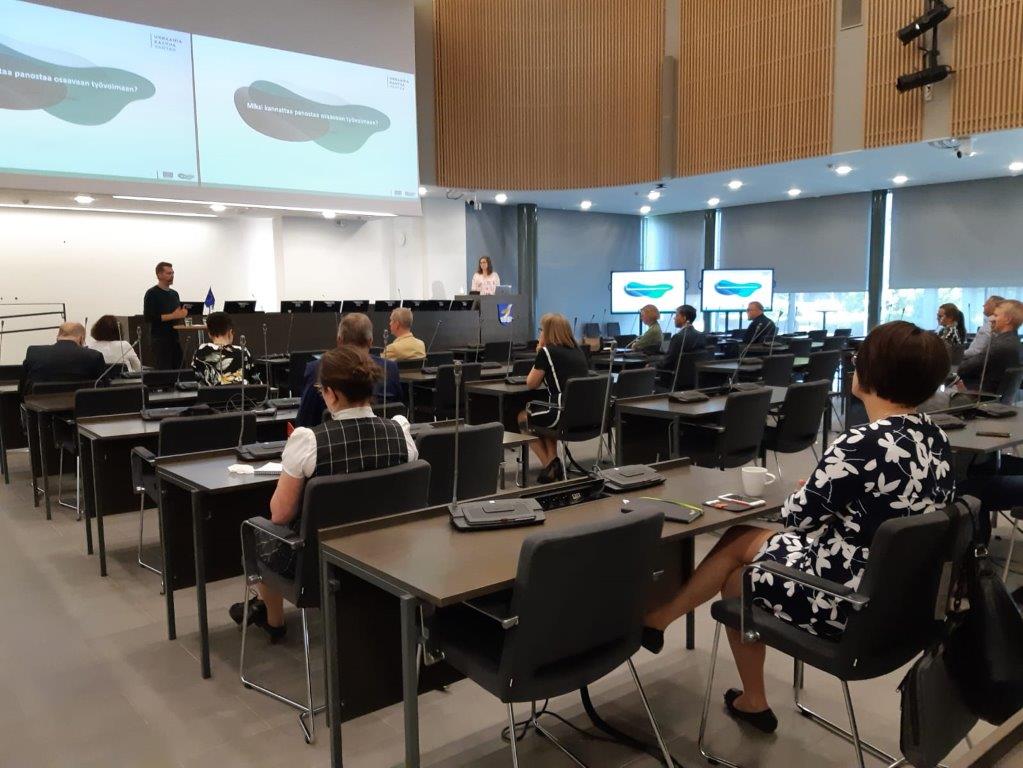How did the Vantaa GSIP Project achieve to develop active employment programmes with strong social impact? The GSIP 1 model case study

As discussed in Zoom-in No.1 of the GSIP (Growth and Social Investments Pacts) Project (https://www.uia-initiative.eu/en/news/how-could-european-cities-promote-solid-active-inclusion-model-zoomin-1), European cities apply very different approaches to active employment programmes, particularly influenced by the broader national social policy context, local needs, interests of key stakeholders and pressure groups and the agendas of social partners who participate in labour market governance. But many local policy makers have started to invest since the deep economic crisis of 2008/2009 in the development of concerted local active inclusion agendas, with the aim to prevent or combat poverty and social exclusion through a concerted set of cash benefits, active employment measures and access to basic services.
As explained in Journal No.1 of the GSIP (Growth and Social Investments Pacts) Project (https://www.uia-initiative.eu/en/news/gsip-expert-journal-1-get-know-project-and-what-happened-first-6-months), the GSIP Project reflects the City of Vantaa key policy decision: i. to promote growth and competitiveness of local companies; and ii. to improve level of education of workforce and offer better training possibilities for low-skilled employees, employees with outdated skills and unemployed persons, through the design and implementation of a new, innovative and exceptional service and incentive model (Growth and Social Investments Pacts - GSIPs).
GSIPs are defined as a new instrument for municipalities to reach the maximum impact on public investments, subsidies and services (including training and vocational education) offered to local companies. GSIPs gather information and expertise about jobs and skills from different national, regional and local institutions and support interested local companies to take in a productive way advantage of them. To increase interest, companies’ employees are offered short free training programmes (partly in class), which deal with different topics on future employment demands (the content is based on previous surveys and interviews).
The GSIPs are tailored for Vantaa based companies employing 10-200 people, particularly companies involved in human intensive and routinely operated industrial sectors and IT-companies which have workforce of outdated skills caused by rapid changes in technologies and future business. They focus on three interrelated policy priorities: a) Recruitment of unemployed persons with low skills and education – The GSIP 1 model; b) Training of existing staff – The GSIP 2 model; c) Use of digitalization processes in the business routine – The GSIP 3 model.
In this respect, the City of Vantaa GSIP Project provides a profound case study about the methods to design and implement active employment programmes with strong social impact, combining efforts to support businesses, employees and unemployed persons. It has created a strong alliance of partners involved in the economic and social development of the Vantaa area, committed to promote an innovative local jobs and skills agenda by increasing capacity and skills of the workforce, providing favourable preconditions for business development and creation of jobs, based on distinctive local specificities. This agenda is carried out through three interrelated interventions (Growth and Social Investments Pacts - GSIPs), the first of which (GSIP model No. 1 “Need for Skilled Workforce”) is typical of a strong social impact labour market initiative (i.e. the integration of unemployed persons with low skills and education in the labour market).
1. The scope of the GSIP model No. 1
The GSIP model No. 1 “Need for Skilled Workforce” highlights the need to include social goals in local active employment programmes. It is the main instrument to achieve the main social objective of the GSIP Project: to foster the labour market integration of unemployed persons through the creation of 200 new jobs and 30 apprenticeships. In this context, the model aims at preventing and combating serious risks related to unemployment through a) recruitment processes for unemployed persons and b) apprenticeships for students.
2. The development process of the GSIP model No. 1
a) The model was designed according to the values and principles of the Co-creation approach, defined as a process to develop new business models, products and services with customers, clients, trading partners and other stakeholders. b) The model was validated through co-creation workshops, interviews and tests in the five Project Partner companies, and included business and workforce analyses; incentive modelling frameworks (sources and combination of national and city level subsidies, social appreciation), recruitment programmes (services designed: counseling, workforce search via networks, education packages, apprenticeship), coaching (topics covered: corporate social responsibility and sales) and training programmes for managers and employees (topics covered: Communication, Customer insight, Supervisory work, Lean and MS Office).

c) The pilot implementation phase focused on Vantaa based companies employing 10-200 people. Almost 91 companies were contacted by phone, approximately 47 companies were met and analyzed, from which 41 companies were involved in the testing process of the model.
d) The implementation phase focused on Vantaa based companies interested to address their actual needs through the creation of new jobs and apprenticeships.
33 pilot companies participated in recruitment programmes, producing 68 open job opportunities for unemployed jobseekers. Recruitment services included: Talent search with 15 companies and 32 open jobs; counseling services for 20 companies; service guidance for 16 companies and job design with 10 companies for 25 different jobs.
Training programmes were implemented by Laurea and Metropolia University of Applied Sciences, and the Helsinki Region Chamber of Commerce provided guidance & online course contents in MS Office courses. Three training options were offered: two coaching (Company image and Sales) and one course programme with generic themes (Communication, Customer insight & Sales, Supervisory work & Leadership, Lean thinking and MS Office).
3. Methodologies and tools of the GSIP model No. 1
The implementation of the GSIP model No. 1 had to address a set of frequent key challenges in the development of local jobs and skills agendas: the identification and awareness of unemployed persons; the identification and awareness of companies; and the provision of incentives to companies interested to create new jobs. Project Partners noticed in time these challenges and designed specific methodologies and tools.
A. The first implementation challenge concerns the identification and awareness of unemployed persons.
The first step in the identification process was the analysis of existing registries and data bases monitored by the Vantaa based TEO (one of the 120 local Employment and Business Service Offices of the Public Employment and Business Service – see https://www.te-palvelut.fi/te/en/index.html). and the City of Vantaa Employment Service Center (a service for over-30-year-old job-seekers that provides personal guidance in issues related to job-seeking and training without advance appointment. It focuses on developing job-seeking facilities and skills as well as vocational competency = see https://www.vantaa.fi/administration_and_economy/employment_trade_and_business/employment_services).
The second step was organizing meetings with specific Vantaa based civil society organizations (Vantaan Järjestörinki ry, Vantaan Työnhakijat ry, Hyvät Tuulet ry, Nicehearts ry, Kalliolan Setlementti ry) involved in the provision of activation and integration services to people at high risk of poverty and social exclusion (including unemployed).
The third step was developing a thematic Communication Strategy for unemployed persons by the following tools: a) a thematic website in Finnish (https://urbaaniakasvua.fi/); b) social channels on twitter (account: @@urbaaniakasvua) and youtube; c) Conferences and Seminars; d) recruiting events (unemployed jobseekers have been contacted at the Megarekry Trade Fair on 3 October 2019, one of the biggest recruiting events in Finland, the Aviapolis Jobs on 28 January 2020 and the Uusio Ura on 4 February 2020); e) a video uploaded in both the Project’s website and the UIA website (https://www.youtube.com/watch?v=SUjC83R49EU).

B. The second implementation challenge concerns the identification and awareness of companies. This was performed during a six steps process.
C. The third implementation challenge concerns the provision of incentives to companies interested to create new jobs. This challenge was addressed through the design and implementation of a new Recruitment Service offered to participating companies, based on the following pillars:
(a) Finding competent people
We help to find people who need the recruitment needs through our networks in different employment services and unemployed people. We assist in interview activities.
(b) Information and guidance
Information: We help companies to utilise available financial support (i.e. salary support, Vantaa add-on) and services. We also help in apprenticeship issues.
Guidance: We help to find right partners to support in recruitment and guide to use the City of Vantaa Yritysohjaamo Service (it acts as a bridge between employers and job-seekers) and the City of Vantaa Employment Service Center, among others. In practice this meant that as recruitment need was identified, project employee will evaluate which service would be the best here and guides the employer to that. Potential service providers include: Employment Service Center, Vantaa Yritysohjaamo, Match-project, Vantaa competence centre, employment service coaching team, disabled services etc. Most of the solutions have a nominated person whom the company representative is guided to contact. In case of none existing, then we help to get the right service.
(c) Recruitment through apprenticeship – service
Apprenticeship helps companies in recruiting new employees as well as in improving existing employee competences / skills. We help in mapping jobs and finding suitable candidates. Planning of the content of education is done by Varia Vocational college.
(d) Organizing and design service based on competent employee needs
We help companies to clarify, organise and when needed, to design their competence map so that they can find appropriate people to fulfil the open vacancies. At the same time new open vacancies will open for the applicants who have challenges in becoming employed.
4. The social results of the GSIP model No. 1
a) 33 companies have used the recruitment service offered by the GSIP Project through direct meetings, phone and email.
b) 20 companies have asked for and received advisory and guidance services on apprenticeship, financial support or use of other service.
c) 16 companies were directed to the City of Vantaa services involved in the development of an active inclusion discourse for unemployed persons and the Vantaa based TEO.
d) Almost 100 unemployed jobseekers have been contacted during recruitment events.
e) At least 100 job vacancies for specific categories of unemployed persons (i.e. migrants, partially disabled, low-skilled and long-term unemployed) were created.
f) 68 new employment contracts were signed.
g) 58 apprenticeships were offered by participating companies.
About this resource
The Urban Innovative Actions (UIA) is a European Union initiative that provided funding to urban areas across Europe to test new and unproven solutions to urban challenges. The initiative had a total ERDF budget of €372 million for 2014-2020.
Similar content




